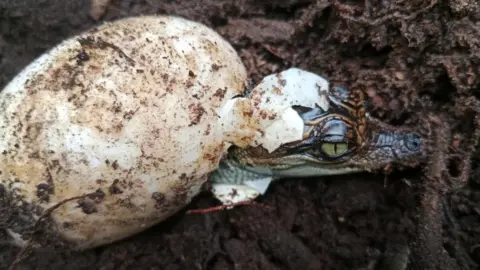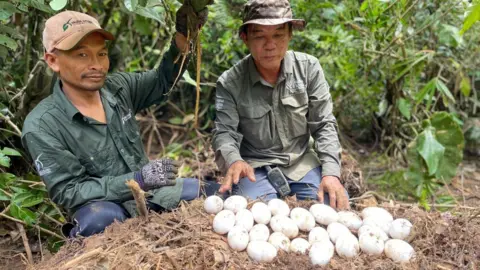Near-extinct crocodiles make comeback in Cambodia
 Bros Pov/Fauna & Flora
Bros Pov/Fauna & FloraCambodia has welcomed 60 baby Siamese crocodiles - a hatching record for the endangered species in this century, conservationists say.
They have called it a "real sign of hope", after more than 20 years of efforts to revive the reptile's numbers in the remote Cardamom Mountains.
The olive green freshwater reptile has a distinct bony crest at the back of its head - by some estimates, it can grow up to 3m or nearly 10ft.
Locals discovered five nests in May and the baby crocs were born at the end of June, conservationists said on Thursday.
 Hor Leng/Fauna & Flora
Hor Leng/Fauna & FloraSiamese crocodiles were once widespread throughout much of South East Asia.
But decades of hunting and habitat loss have tuned them into what conservations classify as "critically endangered" species. There are just 400 of them left in the world - and most of those are in Cambodia.
Given their dwindling population in the wild, "the hatching of 60 new crocodiles is a tremendous boost," said Pablo Sinovas, who leads the Cambodia programme of conservation group Fauna & Flora.
He added that this was hugely encouraging for "collaborative conservation efforts" - in this case the efforts have involved conservationists, local NGOs and the Cambodian government.
The crocs were feared to be extinct until they were rediscovered in Cambodia in 2000.
Mr Sinovas says it Fauna & Flora has since worked with local officials to set up a programme to breed them in captivity before releasing them into suitable habitats across the Cardamom Mountains.
Local community wardens patrol crisscross mountains in regular patrols to ensure that the crocodiles are safe after release.
Since 2012, the programme has successfully let 196 Siamaese crocs back into the wild.
In May locals discovered nests in an area where the crocodiles had not been released before, suggesting that the species have been breeding in their natural habitat.
The conservation team then dispatched people to make sure the nests were protected round the clock - until all the eggs hatched, bringing 60 baby Siamese crocs into the world.
